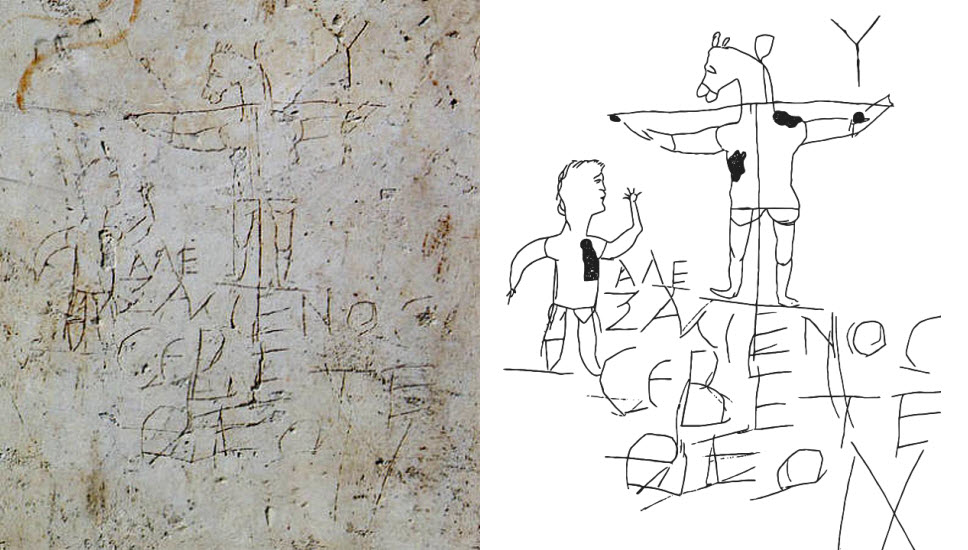
In the Palatine museum in Rome there is a collection of ancient graffiti etched on slabs of marble and limestone that once defaced the walls of palaces and public buildings across the Roman Empire. Among these is one that historians call “Alexamenos graffito”. It depicts a roughly drawn figure of a man with the head of an ass crucified on a cross. Next to the crucified figure is a smaller figure with one arm extended towards the former. Underneath the figures is a caption, written in equally crude letters, that reads “ΑΛΕ ξΑΜΕΝΟϹ ϹΕΒΕΤΕ ϑΕΟΝ”, meaning “Alexamenos worshipping his God.”
Carved sometime between the first and the third centuries, the figure is the earliest known pictorial representation of the crucifixion of Christ and his idolization. The graffiti was discovered on a building complex that was unearthed in 1857 on the Palatine Hill in Rome. The complex of imperial palace was once the house of Emperor Caligula before it became a boarding school for the Roman noble’s messenger boys. It is believed that the graffiti was drawn during this period by a mischievous student to tease another student named Alexamenos, who was apparently a devout Christian. At that time, Christianity was roundly derided by the pagans of the Roman Empire as a strange minority religion, centered on a man punished as a criminal in one of the most humiliating form of execution. The notion of a suffering god was ridiculous to them. Equally absurd was the concept of a savior who was himself defeated by the powers of evil.
Marcus Cornelius Fronto, a 2nd century Roman orator and rhetorician, asserted that “the religion of the Christians is foolish, inasmuch as they worship a crucified man, and even the instrument itself of his punishment. They are said to worship the head of an ass, and even the nature of their father.”
The reference to donkey-worship comes from a story recounted by the Roman historian Tacitus, in which a group of Jews, expelled from Egypt, wandered through the desert, exhausted and dying of thirst, until they were led to water by a herd of wild asses. In turn, they started worshipping the animal that delivered them. The association of Jews with donkeys became a common feature of Hellenistic and Latin historical writings. Christians were mocked for worshipping a donkey head and were even accused human sacrifices.
These depictions must have offended many believers, but some took them in jest. Third-century Christian author Tertullian mentions a peculiar anecdote that occurred in Carthage, where he saw an apostate Jew carry around a picture of man dressed in toga but with the head of an ass and hooves for legs. Rather than feeling insulted, Tertullian was amused at the joke and wrote that “we laughed at both the label and the image”.
But Tertullian also defends his religion. “Our god is the head of an ass,” he wrote, but then he accused pagans that “you in fact worship the ass in its entirety, not just the head. And then you throw in Epona, the patron saint of donkeys and all the beasts of burden, cattle, and wild animals. You even worship their stables. Perhaps this is your charge against us that in the midst of all these indiscriminate animal lovers, we save our devotion for asses alone.”
Aside from that one cheeky engraving, crucifixion was rarely depicted in Christian art until the 6th century. By then, the characteristic beard, shoulder-length hair and long face had become the standard.
References:
# Art and Theology, https://artandtheology.org/tag/alexamenos-graffito/
# Aelius Stilo, https://penelope.uchicago.edu/~grout/encyclopaedia_romana/gladiators/graffito.html
# Judaism and Rome, http://www.judaism-and-rome.org/alexamenos-graffito
# Richard W. Bulliet, Hunters, Herders, and Hamburgers



Probably a pharisee.
ReplyDelete